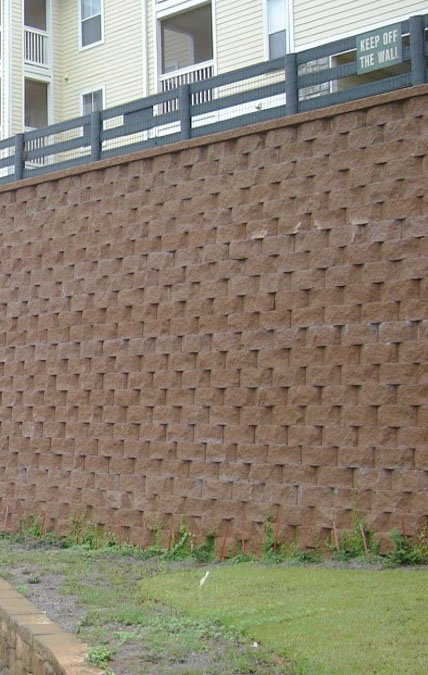Segmental Retaining Walls
Request A Free Quote!
Segmental Retaining Walls
Segmented Retaining Walls can be built of various concrete blocks. Some systems are designed so that the blocks interlock with each other – which provide a mortar-less solution. Segmental Retaining Walls rely on gravity and the blocks are designed to gradually step back into the earth they retain, to provide more strength. There are a huge variety of concrete blocks available, so you can choose are cleaner or a rather weathered look. Most systems allow the integration of curves, corners and stairs, and the blocks can be split to fit the shape of the project.
Segmental retaining walls are constructed by laying several courses and sometimes geogrid fabrics are used to anchor the wall back into the earth behind the wall.
Segmental retaining walls (SRWs) are popular for use as transportation structures, especially bridge abutments, and also for residential landscaping applications. They accommodate grade changes effectively, can be laid in any combination of curved and straight wall sections, and look good. The walls may be vertical or slightly inclined toward the side retaining earth.
Placing a segmental retaining wall unit with a split-face finish. Block is held in place by gravity/friction and with pins between courses.
Segmental retaining walls are single Wythe walls laid without mortar. Units are designed to interlock between courses or to use mechanical devices like connecting pins to resist lateral soil pressure. Walls typically range in height from 8 inches to 20 feet. For added stability on taller walls, geosynthetic fabric can be laid between various courses and embedded in the soil as an anchor.

Segmental retaining wall units are often finished with a decorative color and/or texture. Units are manufactured to conform to ASTM C1372 Standard Specification for Dry-Cast Segmental Retaining Wall Units. The standard includes notes to the purchaser about specifying optional characteristics such as weight classification, high compressive strength, and surface texture, finish, or color where desired.
Segmental Retaining Wall
Segmental Retaining Walls (SRWs) are durable, long lasting retaining wall systems that consist of dry stacked modular units. SRWs are used in many applications including landscaping walls, structural walls for changes in grade, bridge abutments, stream channelization, waterfront structures, tunnel access walls, wing walls and parking area support.
Calgary Retaining Walls offers a number of SRW units ranging from small garden wall units to large structural units. This section focuses on the hand install sized units, while the “Outcropping Design Centre” deals with larger machine install units.
Segmental retaining walls consist of modular concrete blocks that interlock with each other. They are used to hold back a sloping face of soil to provide a solid, vertical front. Without adequate retention, slopes can cave, slump or slide. With the unique construction of segmental retaining walls, higher and steeper walls can be constructed with the ability to retain the force of lateral earth pressure created by the backfill soil.
Segmental retaining walls can be installed in a wide variety of colors, sizes, and textures. They can incorporate straight or curved lines, steps, and corners. They are ideal for not only slope support, but also for widening areas that would otherwise be unusable due to the natural slope of the land. Retaining walls are often used for grade changes, and for other functional reasons such as widening driveways, walkways, or creating more space in a patio outdoor area.
What are Concrete Segmental Retaining Walls?
Segmental retaining walls consist of a facing system and a lateral tieback system. The facing systems usually consist of modular concrete blocks that interlock with each other and with the lateral restraining members. The lateral tiebacks are usually geogrids that are buried in the stable area of the backfill. In addition to supporting the wall, the geogrids also stabilize the soil behind the wall. These two factors allow higher and steeper walls to be constructed.
Advantages of Concrete Segmental Retaining Walls
Segmental retaining walls offer many advantages:
- Rapid construction
- Horizontal and vertical curvatures
- Easy grade changes
- A wide variety of colors, sizes and textures
- No need for a concrete footing
Some segmental systems use steel or fiberglass pins, clips or integral lips to create a continuous facing system. Some blocks are hollow, some are solid. Just about all block systems permit backfill drainage through the face joints.
